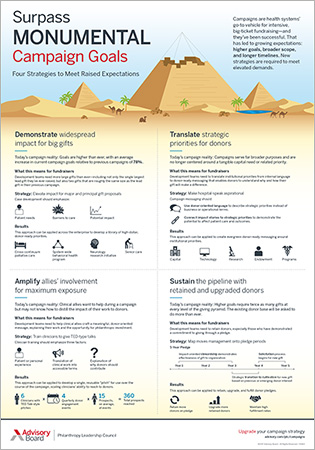Auto logout in seconds.
Continue LogoutRead Advisory Board's take: 3 imperatives for your grateful patient program
An increasing number of nonprofit hospitals are seeking large monetary donations from patients through so-called "grateful patient programs," but some experts are questioning whether the hospitals' strategies for identifying patient donors are ethical, Phil Galewitz reports for the New York Times.
The rise of 'grateful patient programs'
Grateful patient programs are becoming increasingly popular at U.S. hospitals. An Advisory Board survey of 108 hospitals found more than half had grateful patient programs, and "in the last 10 years we've seen a pretty dramatic uptick in strategic attention in the formation of these programs," said Nicholas Cericola, a practice manager at the company.
Grateful patient programs rely on a combination of software and patient information to identify and connect with patients who are potential donors, Galewitz writes. Most hospitals use public data, like information on patients' charity contributions and property records, to perform wealth screenings to determine which patients are most likely to donate large monetary gifts. In some cases, hospital staff, including doctors and nurses, are trained to identify the patients who are most satisfied with their care and, therefore, might be more willing to donate.
Once the patients are identified, some hospitals will offer the patients extra amenities, such as robes and nicer waiting rooms for their families. Fundraising staff and hospital executives eventually ask patients for donations through conversations that are held in the patients' hospital rooms or their homes.
Data suggest that grateful patient programs are helping hospitals improve their bottom lines. Across the country, hospitals received over $10.4 billion in donations in 2017, up from $6 billion in 2004, according to the Association for Healthcare Philanthropy. Alice Ayres, the association's CEO, said the increase in donations is a direct result of grateful patients programs and a shift toward hospitals seeking larger donations.
Why are hospitals asking patients for money?
According to Galewitz, patient donations are a crucial supplement to hospitals' incomes from public and private insurance programs, as well as donations from charities and typical fundraising events, such as golf tournaments and galas.
"It's a way to get money to the hospital's bottom line like nothing else," said Bill Tedesco, CEO of DonorSearch.
For hospital system Sharp HealthCare, patient and family donations made up two-thirds of the $34 million it received in donations last year, according to fundraising CEO Bill Littlejohn.
Littlejohn said wealth screenings and training staff to participate in fundraising is "crucial" to the process. According to Galewitz, the hospital system performs nightly wealth screenings of up to 400 patients, and adds 10 to 20 potential patient donors to the list each night.
Once selected, Littlejohn said he does not ask the patients for a donation outright, but instead he tells patients that he "appreciate[s] them choosing Sharp and hope they have a wonderful experience." He added, "I use [the conversation] as a get-to-know-you opportunity and let them know Sharp is a nonprofit and philanthropic-supported institution." Littlejohn said the conversations lead to 20% of the patient donations the Sharp receives.
Are patient donation programs 'unseemly' or part of the process?
But some patients do not welcome the donation requests, and some clinicians have raised ethical questions about the programs.
Marcy Grupp received a letter from St. Clair Hospital one month after she visited the ED for a kidney stone. The letter asked Grupp for a "gift of gratitude" in the form of a donation.
Grupp said she "resent[ed]" the solicitation letter. "I don't think they need the money," she said, adding, "I thought the care I got was good and the doctors I had were good, but I don't see why I need to pay in addition to what I've already paid."
Rosalyn Stewart, an internist at Johns Hopkins Hospital, said this type of fundraising also can make some "doctors very uncomfortable for a lot of reasons—No. 1 is that the doctor is there to see the patient for a problem they have and not to ask the patient for money."
Stewart added that she fears the increasing popularity of patient donation programs might lead to wealthy patients being treated better than patients who are not potential big gift donors. "I feel like the risk is we are setting up a two-tiered health care system—one for wealthy patients and one for everyone else," she said.
However, Frederick Finelli, a surgeon and VP of medical affairs at Med Star Health's Montgomery Medical Center, said he thinks fundraising is an important part of the care process. "When someone says 'Thanks' to me, it feels incomplete for me to just tell them, 'No problem,'" he said. "Talking to patients about philanthropic or volunteer needs is good for patients."
And some patients say they are more willing to give donations when they know why the money is needed.
Martin Faga was identified as a potential donor when he was treated at Inova Fairfax Hospital, but he initially was not interested in giving a donation. However, when fundraising staff told Faga that his donation would help train staff and purchase equipment for the hospital, he changed his mind and made a $200,000 donation (Galewitz, New York Times, 1/24).
Advisory Board's take

Nicholas Cericola, Practice Manager, Philanthropy Leadership Council
Grateful patient fundraising programs have become fairly commonplace practice at nonprofit hospitals and health systems, but stories like this raise important questions about the underlying ethics of their tactics. Before addressing those questions, it's worth providing some context on why grateful patient programs exist.
“Philanthropy often contributes 20% or more of a hospital's margin”
First, philanthropy often contributes 20% or more of a hospital's margin. It allows hospitals to make investments in beneficial new programs, technologies, and research that might not otherwise be possible. In particular, philanthropy can be a critical source of funding for programs that aren't reimbursed by private insurance companies or government programs. For example, Bridgeport Hospital recently used private donations to fund transportation for more than 600 patients who otherwise wouldn't have been able to afford a trip to the hospital.
Yes, some hospitals do offer certain non-clinical service amenities to VIP patients—including top donors—but those amenities are distinct from actual care delivery. Focusing on these relatively uncommon service touches obfuscates the reality that philanthropy pays for investments that improve the health outcomes and care experiences of many.
“Many patients want to give back—even without prompting”
Second, many patients want to give back, even without prompting. A recent Advisory Board survey of nearly 2,000 patients and patient family members found that one in six sent a personal thank you note, non-monetary gift, or monetary donation to their health care provider in the last three years. The large majority of those expressions of gratitude were unsolicited.
That's not to say that every grateful patient fundraising strategy is beyond reproach—the intent and practical effects of these strategies matter greatly. As a baseline, fundraising practices should adhere to the highest ethical and legal standards. Beyond that, they should directly align with the goals of removing disparities from the health system, improving access, and elevating the quality of care. Here are three essential imperatives to follow:
- Offer patients—or any prospective donor—the opportunity to invest directly in programs that will have a positive impact on others. Emphasize the potential impact of a philanthropic contribution using compelling data and personal stories. If you choose to reward top donors with the promise of special amenities, do so only as a secondary consideration and with a solid firewall between the extra services and care delivery.
- Use patient data and wealth screening tools to avoid inappropriate outreach to patients and engage likely donors. Inevitably, you're going to reach out to many patients who don't want to donate, but that's no excuse for complacency. As a minimum, use available data and tools to reduce fundraising communications with individuals who may not have the means or desire to be philanthropic.
- Involve clinicians, but do so selectively and on terms that they agree with. In a recent survey of 262 physicians, 87% said they have a "positive" or "very positive" perception of philanthropy's impact at their organization, and six out of ten indicated a willingness to become more involved in philanthropy activities at their hospital. But no clinician should be pressured into connecting their patients to hospital fundraisers, and fundraising staff need to be cognizant of their own resource limitations when asking doctors and nurses to get involved. That said, there's ample room to scope roles for providers that protect their primary responsibility to patients while helping to broker deeper relationships with philanthropic individuals.
Ultimately, acts of philanthropy are deeply personal for the donor, and especially so for patients who have received life-altering treatment. Grateful patient programs are a means of helping patients to decide for themselves whether they want to provide philanthropic support to the hospital—support which can be of great benefit to others like them.
Watch this webconference recording to learn more about the opportunity for physician-philanthropy partnerships and to overcome the number one barrier to engaging doctors in grateful patient fundraising.
For additional guidance on building and executing a successful grateful patient program, visit our Grateful Patient Program Resource Suite and our Philanthropy-Physician Partnership Toolkit.
Don't miss out on the latest Advisory Board insights
Create your free account to access 1 resource, including the latest research and webinars.
Want access without creating an account?
You have 1 free members-only resource remaining this month.
1 free members-only resources remaining
1 free members-only resources remaining
You've reached your limit of free insights
Become a member to access all of Advisory Board's resources, events, and experts
Never miss out on the latest innovative health care content tailored to you.
Benefits include:
You've reached your limit of free insights
Become a member to access all of Advisory Board's resources, events, and experts
Never miss out on the latest innovative health care content tailored to you.
Benefits include:
This content is available through your Curated Research partnership with Advisory Board. Click on ‘view this resource’ to read the full piece
Email ask@advisory.com to learn more
Click on ‘Become a Member’ to learn about the benefits of a Full-Access partnership with Advisory Board
Never miss out on the latest innovative health care content tailored to you.
Benefits Include:
This is for members only. Learn more.
Click on ‘Become a Member’ to learn about the benefits of a Full-Access partnership with Advisory Board
Never miss out on the latest innovative health care content tailored to you.

